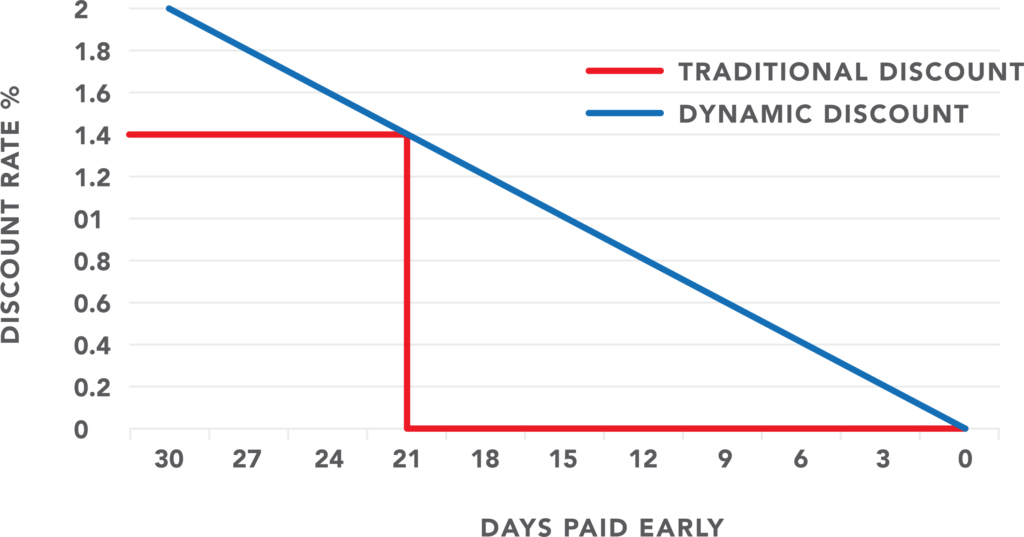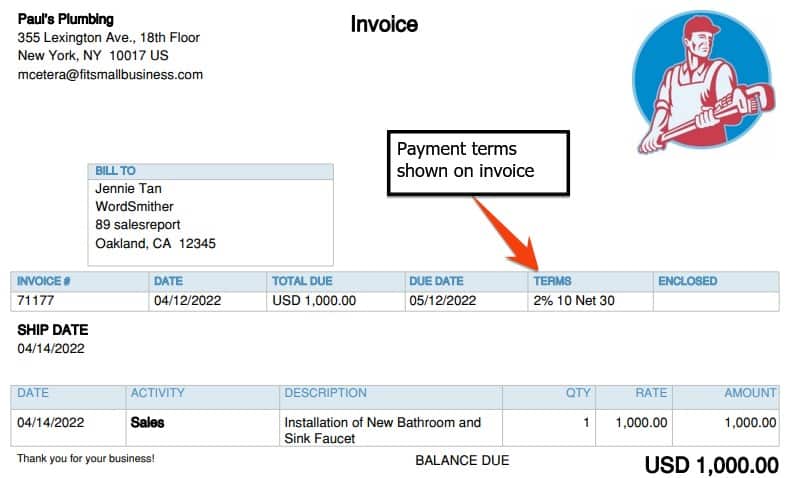
This article is part of a larger series on Bookkeeping.
Download our FREE Guide
Send to me TABLE OF CONTENTSAn early payment discount―also called a prompt payment or cash discount―is a reduction in an invoice balance when it’s paid before the due date. It provides an incentive for customers to pay their bills before they’re due.
When used strategically, early payment discounts can speed up the bookkeeping process, increase customer loyalty, and improve cash flow. Our guide covers how to calculate it, its benefits, guidance on if you should offer it and how much to give, and more.
To calculate early payment discounts, multiply the total invoice amount by the discount percentage. Next, subtract the discount amount from the total invoice amount to get the payment due on the invoice.
Discount = Invoice Amount x Discount Rate
Net Invoice Amount = Invoice Amount – Discount
So, assume you invoice a customer for $850 with a discount term of 2/10 Net 30:
This means that the customer can pay $833 instead of $850 if they settle the bill within 10 days of the invoice date.
It’s important to understand common payment terms when calculating early payment discounts and applying them to your invoices.
Payment terms can help you manage accounts receivable (A/R) and convert them to cash immediately. Read our article about A/R best practices to learn more.
Early payment discounts have benefits for both vendors and customers beyond the obvious one of saving the customer money.
When deciding whether implementing early payment discounts is a good strategy for your business, you should consider the following questions:
Offering early payment discounts can help speed up invoice collection. Managing invoices is an important bookkeeping responsibility. Our small business bookkeeping guide teaches you all essential bookkeeping responsibilities you should know.
The discount a vendor offers will vary based on several factors.
There’s no rule that you must offer every customer the same payment terms. If you offer different terms, however, be sure to follow a written policy to justify the terms offered to defend against potential accusations of favoritism or discrimination.
Tip: Implementing early discount payments can be tedious if you’re relying on manual bookkeeping. Accounting software like QuickBooks Online allows you to set up specific terms for each customer. Simply set up the discount terms when creating an invoice or sales receipt, and the program will calculate and apply early payment discounts to your invoice automatically.
The terms of an early payment discount should be clearly stated on all invoices. Generally, payments must be received by the vendor within the stated number of days from the invoice date for the discount to be applied.
However, some clients will try to take the discount as long as their check is written within the discount period. You should establish a firm rule regarding this issue and display it at the bottom of all invoices that include an early payment discount.
If giving early payment discounts won’t work for some customers, you can try alternatives that can help maximize your finances without compromising your healthy relationships with them.
Instead of giving a fixed discount rate for a certain number of days, you can offer dynamic discounting to provide a win-win situation between you and your customers. Through it, you’re offering a sliding-scale discount without pressuring them to pay within the fixed discount period.
Dynamic discounting works by providing a discount throughout the credit period. However, customers can get a higher discount if they pay earlier or a lower discount if they pay later.
The image below shows the comparison between dynamic and traditional discount programs. Under the traditional discount program, the discount is no longer available after 10 days, while the dynamic discounting model reduces the discount rate as the invoice comes due. However, dynamic discounting requires specialized software.

Traditional vs Dynamic Discounting (Source: xpedize.com)
If dynamic discounting is a bit complicated for your needs, you can explore receivable factoring. Factoring is basically “selling receivables” to a factor, or buyer of receivables. By selling receivables, you’re transferring to the factor the rights to collect the amount due from your customers, plus you agree that certain fees will be deducted.
Receivable factoring may not be an affordable option, but it can be a solution to recover overdue accounts. Factoring will deduct a factoring fee and factor’s holdback from the total amount of receivables factored. Hence, you’ll not receive the total amount of receivables factored, but it can help you recover cash for working capital needs.
If you’re unfamiliar with this alternative, our article on A/R financing discusses costs, terms, qualifications, and more. You can also see our guide on the best invoice factoring companies for our recommendations.
How Early Payment Discounts Work with QuickBooks OnlineSuppose Paul’s Plumbing invoices a customer for the installation of a new bathroom and sink faucet for $1,000. The term for the early payment discount is 2%/10 Net 30, so if you receive payment in 10 days or less, the invoice will be reduced to $980. If the customer pays after 10 days, they must pay the full $1,000. The screenshot below shows how this payment term is displayed on an invoice from QuickBooks Online.

Sample invoice created in QuickBooks with early payment discount terms
How To Set an Early Payment Discount in QuickBooks Online
If you’re a QuickBooks Online user, you can add a discount to an invoice or sales receipt for customers who pay early by turning the Discount feature on. To do this, click on the gear icon on the top right part of your dashboard, select Account and Settings, and then choose Sales. From the Sales form content tab, toggle Discount to on.

Turn the Discount feature on in QuickBooks Online

Adding Discount Terms on QuickBooks
When creating an invoice, a discount field appears on your sales form. Indicate your customers’ discounted payment terms for early payments.
Yes, as early payment discounts can help establish long-term relationships with customers. It can also encourage them to pay early, which would help you recover cash to be used for operations.
Where do discounts go in the income statement?Discounts are deducted from gross sales using the account title “sales discounts.”
Depending on your needs and goals, offering early payment discounts can help speed up the collection process—but it can also pose some challenges, especially when not implemented properly. It’s best to consult your accountant or bookkeeper to analyze the impact of early payment discounts on your business.
If you decide that early payment discounts are a win-win for you and your customers, you should leverage your accounting software to apply discounts to your invoices automatically.